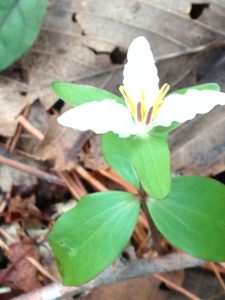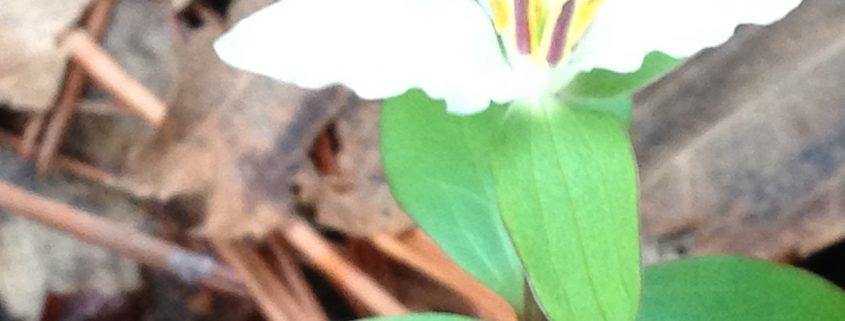Fourth Week LearningQUEST and THRIVE Update
March 7, I completed the fourth of my six-week lecture series at LearningQUEST and THRIVE Assisted Living. In case you missed it, here is my second week post on the series: https://stevejonesgbh.com/2018/02/26/learningquest-thrive-lectures-update/
Today’s Featured Image (a least or dwarf trillium; Trillium pusillum) signals only the season. I snapped the photo just a few days prior to this March 7 lecture session.
LearningQUEST Fourth Week Update
Our Wednesday morning group is jelling. We are enjoying these too-brief sessions on Nature-Inspired Learning and Leading. Our interests are taking us into areas I had not specifically anticipated in my advance six-week course notes, which is good — a signal of flowing and evolving interest. I had in an earlier session set the context for how utterly alone we are as residents of this Earth — our mote of dust in the vast darkness of space. I had mentioned that at the speed of light, a photon would take 25,000 years to travel from our planet to the center of the Milky Way Galaxy. In contrast, our Voyager space probe, now forty years launched and exiting our solar system, would take at its current speed, 455 million years to cover the distance to the galaxy’s center.
Discussion reminded some of us of a video we recalled from some time ago. So, on the fourth session Wednesday, participant Jim Harlow projected the nine-minute video on Powers of Ten (https://www.youtube.com/watch?v=0fKBhvDjuy0). We are all fascinated by the seeming infinite breadth and depth of this amazing world we occupy and the insignificance of our place within it.
We discussed at length the work of Peter Wohlleben, a German forester featured in the most recent Smithsonian magazine. Wohlleben posits that a forest is a complex community of interconnected individuals communicating and cooperating in a manner somewhat anthropomorphic. We enjoyed our discussion. Although we did not view this video (below), I offer it here in case you may want to dig into Wohlleben’s work and philosophy. His views are not without detractors and staunch supporters. This video serves as a teaser. Much more is available via an internet search.
The Smithsonian article also presented the work of Dr. Suzanne Simard, a British Columbia ecologist. Again, we discussed Dr. Simard’s work based only upon the article and what participants may have gleaned from the internet. We did not vies her TED talk (below); I include it here for you information. Both Simard and Wohlleben add a dimension to forest ecology and plant physiology that is provocative. I appreciate their entry into the field, even as I remain skeptical, particularly of Wohlleben’s stronger views toward personifying tree behavior and implied intent.
The notion of trees communicating led me to suggest at this fourth session that clearly we see intraspecies cooperation and communication throughout the animal world: bees, ant colonies, the wolf pack, whales, and others. Jim and I found a wonderful video of a bird flock phenomenon, murmuration, and showed it this fourth week (below). I have said often that every lesson for living, learning, serving, and leading is either written indelibly in or is compellingly inspired by Nature. Try viewing this murmuration video without drawing inspiration!
Life on Earth is filled with beauty, magic, wonder, and awe, whether its an interconnected forest community or the symphony of birds in flight. I offer these examples to stimulate your own thinking and encourage your exploration.
THRIVE Fourth Week
We do not have an easy way of showing videos at this assisted living venue. I speak to the residents in the dining hall, beginning as they finish eating and work on dessert. We elect not to head upstairs to the theater, believing that the transition would discourage too many from participating. I am learning better how to interact with the residents. I had come the first week thinking that my LearningQUEST notes would suffice to guide me through the THRIVE lecture. I’ve modified to the extent necessary to connect in harmony with this group’s interests. I have found my pace and can resonate. We are having fun!
The third week, I focused on my Alaska adventures as Chancellor, University of Alaska Fairbanks, simply relating tales of travel, weather, food, etc. I read several selections from Robert Service. We also discussed William Bartram’s travels here in the southeastern US and, in particular, Alabama.
The fourth week, we delved into spring’s progress, reviewing what’s in flower and what’s soon to come. A resident brought an exquisite framed photo she had taken years ago — a Canada goose paddling along a placid lake shore under a weeping willow tree. I read from The Nature of Leadership (Covey, Merrill, and Jones).
I read, too, from Louis Bromfield’s Pleasant Valley, his non-fiction book about his beloved Ohio farm and his adult-life commitment to rehabilitating its “old, worn-out” soil. A prominent conservationist, Bromfield wrote some 30 best selling books, many made into successful Hollywood movies mid-20th-century. Humphrey Bogart and Lauren Bacall wedded at his Ohio farmhouse.
I’ve encouraged residents and staff to assemble a library collection of the Nature books I’m introducing. As soon as the weather permits (been either too wet or too cold these first four weeks), we are planning to meet on the large back patio, closer to Nature. I will encourage them to recognize their special Nature niches, and know them, enjoy them, and cherish them.
Reflections
I am learning from both groups. Like so much in Nature, each individual and collective is special. Although I am facilitating, it is they from whom I am learning better to Believe, Look, See, and Feel the Power and Wisdom of Nature.
I feel as though the trillium signals the new blossoming I am experiencing. The hope and promise of a rebirth within me. Some would have viewed my early spring hike through the Beaverdam tupelo swamp as dark, dismal, and even foreboding. To me, anything but. The trillium colony simply served as exclamation mark. Judy and I, inbound, did not see the flowers, instead focusing on the overstory reaching high above us, supported by large trunks, standing thick and straight. Only upon completing the boardwalk circuit did we spot the dwarf trillium and a few purple trillium buds ready to open. As so often is the case, Nature is always within reach and view to those willing to seek its beauty, bounty, and inspiration.
My hope is to instill in both groups that same yearning for Nature that weaves through all that I do.




